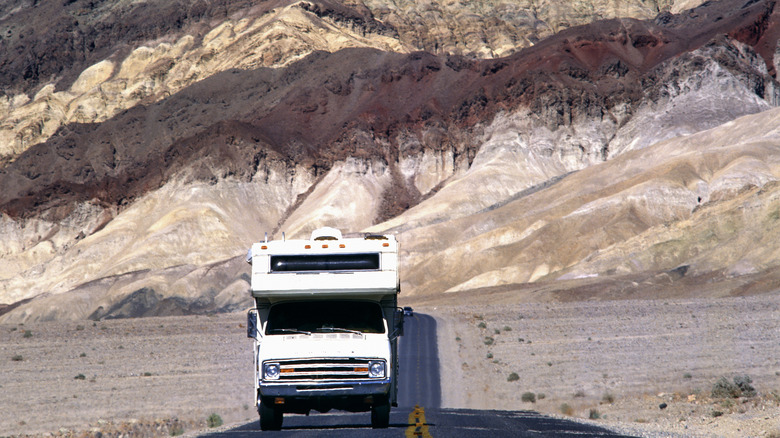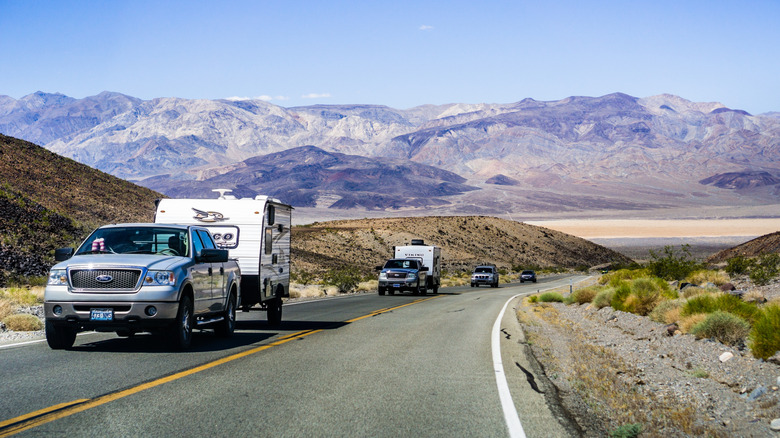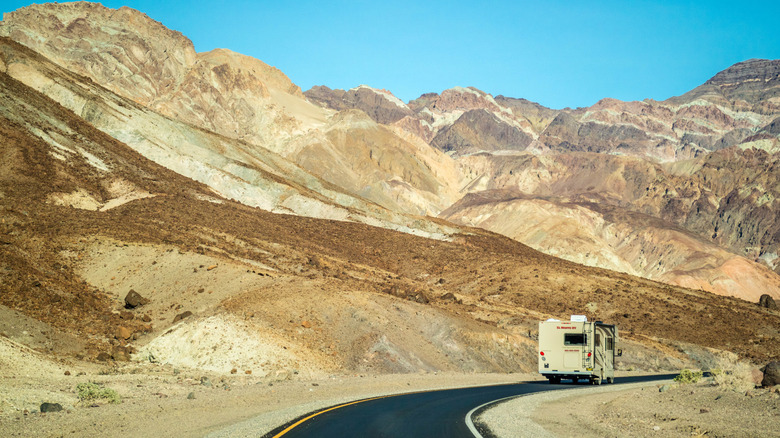Why Driving An RV Through Death Valley National Park During Summer Is A Dangerous Gamble
When you think of Death Valley, California, what is the first thing that comes to mind? If the word "hot" springs into your thoughts, you aren't wrong. Known for its scorching temperatures, beautiful mars-like landscapes, and extraordinary hiking trails, this unforgiving area of Eastern California, just two hours away from Las Vegas, is one of the hottest places on Earth. Now, planning a successful RV trip takes a lot of preparation. With an average summer temperature reaching an outstanding 113°F, driving an RV through Death Valley National Park during the summer may be a dangerous gamble.
While Death Valley may not rank as one of the best US National Parks for your next backpacking adventure, driving an RV through the park can be a positive, or negative, experience when it comes to testing your vehicle's limits in the dangerous summer heat. In order to have a safe road trip through Death Valley National Park, you'll need to realize that what may look like a flat and salty lowland isn't so flat, and could potentially wreak havoc on your RV's brakes, causing them to overheat.
Unsuspecting RV drivers traveling through Death Valley are often surprised by the steep descent along California State Route 190 (CA-190), particularly at the notorious mile high Towne Pass. This stretch drops dramatically from an elevation of 1,926 feet near Panamint Springs down to just 10 feet at Stovepipe Wells. Just in 2024, the National Parks Service reported on their website that six tractor trailers as well as one fifth wheel trailer had their brakes cause fires while descending steep gradients along CA-190, ultimately causing the vehicles to submit to the flames.
Death Valley's slopes and scorching heat: A perfect storm for brake fires
There are many awesome things to do in Death Valley National Park (besides frying an egg on the hot pavement) that will make your RV trip a memorable one. Besides staying at amazing hotels and campgrounds with epic views of the otherworldly landscapes, being ready for the harsh conditions is a sure-fire way (no pun intended) to pull off an unforgettable RV adventure.
Unlike driving on everyday roads, Death Valley National Park's Towne Pass has an infamously steep gradient that burns up vehicle brakes like no other place on Earth. Scorching high temperatures are already putting strain on your vehicle, and if you approach the gradient at a high rate of speed, then ride your brakes descending, you're almost guaranteed a brake failure; or worse, a brake fire, which can ruin your holiday or lead to dangerous consequences.
Brake fires are a common issue while driving through Death Valley National Park due to the extreme heat and excessive friction created from applying the brakes, especially down a steep gradient. In a case where you are likely to "ride your brakes" much more, such as down a steep descent, the friction between the brake pads and the rotors can generate heat in a way where if the brakes cannot dissipate the heat quickly enough to cool down, they can catch on fire. Braking too hard or too often can damage your rotors, causing them to warp. It can also lead to brake pad failure and cause what is called "glazing." This happens when the brake pads get way too hot and harden, reducing their ability to grip and making it much harder — or in some cases, impossible — to stop safely.
Don't get burned: Safety tips for RVing through Death Valley's hot roads
Being well-prepared can make the difference between a memorable trip and a dangerous situation, especially when navigating the roads of Death Valley National Park. Like any road trip, it's important to thoroughly inspect your vehicle both before and during your RV journey. Checking that everything is in good working order, especially critical components like brake pads, brake fluid, tire tread, and pressure, will help ensure you're ready to hit the road safely and confidently.
Brake fluids can easily heat up to the point of boiling temperatures, which then cause hydraulic pressure loss and can lead to brake failure. Braking in extreme heat, like in Death Valley, should be approached with caution and some know-how. To avoid burning out your brakes, avoid aggressive driving, since braking hard and often can cause them to overheat quickly. On the other hand, avoid riding your brakes as, just like aggressive driving, hard and frequent braking can quickly raise the temperature of your braking system. Instead, control your speed before reaching a downhill grade. Let the vehicle naturally slow with the slope when possible, and use lower gears to maintain control. This reduces the strain on your brakes and lowers the risk of overheating or brake fires.
Heat can also wreak havoc on tires, which may make them more prone to punctures driving on gravel, or rocky terrain. Carrying a spare tire, as well as a tire repair kit and knowing how to change a flat, is important to avoid being stranded in the harsh elements and can be a crucial safety skill to learn. Brushing up on basic mechanical knowledge can be a lifesaver in a situation where you may find yourself stranded in the extreme heat of Death Valley.


